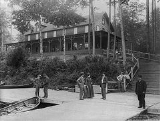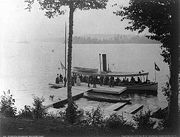
Raquette Lake
Encyclopedia

Source (river or stream)
The source or headwaters of a river or stream is the place from which the water in the river or stream originates.-Definition:There is no universally agreed upon definition for determining a stream's source...
of the Raquette River
Raquette River
The Raquette River, sometimes spelled Racquette, originates at Raquette Lake in the Adirondack Mountains in New York. long, it is the third longest river entirely in the state of New York....
in the Adirondack Mountains
Adirondack Mountains
The Adirondack Mountains are a mountain range located in the northeastern part of New York, that runs through Clinton, Essex, Franklin, Fulton, Hamilton, Herkimer, Lewis, Saint Lawrence, Saratoga, Warren, and Washington counties....
of New York
New York
New York is a state in the Northeastern region of the United States. It is the nation's third most populous state. New York is bordered by New Jersey and Pennsylvania to the south, and by Connecticut, Massachusetts and Vermont to the east...
State
U.S. state
A U.S. state is any one of the 50 federated states of the United States of America that share sovereignty with the federal government. Because of this shared sovereignty, an American is a citizen both of the federal entity and of his or her state of domicile. Four states use the official title of...
, USA. It is near the community of Raquette Lake, New York
Raquette Lake, New York
Raquette Lake is a hamlet in the Town of Long Lake in Hamilton County, New York, United States.The community is located on New York State Route 28 by the west town line. Raquette Lake is located on the west side of the lake, Raquette Lake....
. The lake has 99 miles (160 km) of shoreline with pines and mountains bordering the lake. It is located in the towns of Long Lake
Long Lake, New York
Long Lake is a town in Hamilton County, New York in the United States. The population was 852 at the 2000 census. The town is named for long Long Lake beside which it sits. The town is entirely within the Adirondack Park and is the most northerly town in the county. It is a summer tourism...
and Arietta
Arietta, New York
Arietta is a town in Hamilton County, New York, United States. The population was 293 at the 2000 census. The town was named after the mother of one of the first settlers, Rensselaer Van Rennslaer...
, both in Hamilton County
Hamilton County, New York
Hamilton County is a county located in the U.S. state of New York. It is named after Alexander Hamilton, the only member of the New York State delegation who signed the United States Constitution in 1787 and later the first United States Secretary of the Treasury. Its county seat is Lake Pleasant...
.
The origin of the name is uncertain. One account is that it was named for snowshoes (raquette in French) left by a party of Tories led by Sir John Johnson in 1776. Traveling by snowshoe, they were overtaken by a spring thaw when they reached the lake. They left the snowshoes en masse on the shore.
Raquette Lake developed into one of the most prestigious summer getaways for the elite in the 19th century. In 1877, William West Durant
William West Durant
William West Durant was a designer and developer of camps in the Adirondack Great Camp style, including Camp Uncas, Camp Pine Knot and Sagamore Camp which are National Historic Landmarks. He was the son of Thomas C. Durant, the financier and railroad promoter who was behind the Crédit Mobilier...
started work on what would become the first of the "Great Camps
Great Camps
Great camps refer to the grandiose family compounds of cabins that were built in the latter half of the nineteenth century on lakes in the Adirondacks such as Spitfire Lake and Rainbow Lake. The camps were summer homes for the wealthy, where they could relax, host or attend parties, and enjoy the...
," Pine Knot
Camp Pine Knot
Camp Pine Knot, also known as Huntington Memorial Camp, on Raquette Lake in the Adirondack Mountains of New York State, was built by William West Durant. Begun in 1877, it was the first of the "Adirondack Great Camps" and epitomizes the "Great Camp" architectural style...
. Other summer homes in the "great camp style" on Raquette Lake include North Point (the 1870 buildings replaced by Lucy Carnegie in 1903), Echo Camp
Echo Camp
Echo Camp, also known as Echo Point Camp is an Adirondack Great Camp on the tip of Long Point adjacent to Camp Pine Knot on Raquette Lake. It was used as a private girls' camp from the mid-1940s to the mid-1980s. It was sold in 1986, and is now a privately owned summer residence.Built for...
(1883) and Bluff Point (1876).
Raquette Lake served as a mid-point to other Gilded Age retreats such as the Great Camps Sagamore (1897 now a National Historic Landmark
National Historic Landmark
A National Historic Landmark is a building, site, structure, object, or district, that is officially recognized by the United States government for its historical significance...
), Camp Uncas
Camp Uncas
Camp Uncas, begun in 1890, was the second Adirondack Great Camp built by William West Durant for his own use, after Camp Pine Knot, which he sold to industrialist Collis P. Huntington, due to financial difficulties. It was built on the shore of Lake Mohegan, near Sagamore Camp...
(1890) Uncas became a National Historic Landmark Fall 2008, and Kamp Kill Kare (1896) on nearby lakes Sagamore, Mohegan, and Kora, respectively. Sagamore is open to the public for guided tours during non-winter months and also as an educational facility.
Raquette Lake is still popular, especially in summer, due to the scenery, wildlife, boating and hiking. There are several children's summer camps, including Raquette Lake Boys Camp and Raquette Lake Girls Camp
Raquette Lake Camps
Raquette Lake Camps are located in the center of the Adirondack Mountains in upstate New York, west of Lake George and south of Lake Placid. They are approximately 5 hours from Boston, Philadelphia, Montreal, and the metro New York area. Campers come from 18 different states and 10 countries....
. In winter, substantial snowfall makes the area popular for snowmobiling, cross-country skiing, and snowshoeing.
Bluff Point and William West Durant
Bluff Point is still a private camp and run much as it was over 100 years ago. It was built by Francis Stott of Stottville, New YorkStottville, New York
Stottville is a hamlet in Columbia County, New York, United States. The population was 1,375 at the 2010 census.Stottville is in the south part of the Town of Stockport, south of Stockport Creek.-Geography:...
, at the suggestion of Dr. Thomas C. Durant
Thomas C. Durant
Thomas Clark Durant, was an American financier and railroad promoter. He was vice-president of the Union Pacific in 1869 when it met with the Central Pacific railroad at Promontory Summit in Utah Territory...
. Durant and Mrs. Stott's family had briefly been in business together as Durant, Lathrop & Co. in Albany, New York
Albany, New York
Albany is the capital city of the U.S. state of New York, the seat of Albany County, and the central city of New York's Capital District. Roughly north of New York City, Albany sits on the west bank of the Hudson River, about south of its confluence with the Mohawk River...
, during the 1840s. When Bluff Point was sold to magazine publisher Robert Collier
Robert Collier
Robert Collier may refer to:*Robert Collier, 1st Baron Monkswell , English judge*Robert Collier, 2nd Baron Monkswell , Liberal politician*Robert Collier, 3rd Baron Monkswell , British aristocrat and writer...
in 1905, most of the original structures were modified and expanded into the present score of buildings — the huge walk-in fireplace, the bowling alley, the bridge to the gazebo, etc.
Pine Knot and William West Durant
Pine Knot, Uncas and Sagamore were designed using natural materials native to the Adirondacks by William West DurantWilliam West Durant
William West Durant was a designer and developer of camps in the Adirondack Great Camp style, including Camp Uncas, Camp Pine Knot and Sagamore Camp which are National Historic Landmarks. He was the son of Thomas C. Durant, the financier and railroad promoter who was behind the Crédit Mobilier...
, the son of Thomas C. Durant
Thomas C. Durant
Thomas Clark Durant, was an American financier and railroad promoter. He was vice-president of the Union Pacific in 1869 when it met with the Central Pacific railroad at Promontory Summit in Utah Territory...
. The senior Durant was most famous for the building the eastern half of the Transcontinental Railroad
Transcontinental railroad
A transcontinental railroad is a contiguous network of railroad trackage that crosses a continental land mass with terminals at different oceans or continental borders. Such networks can be via the tracks of either a single railroad, or over those owned or controlled by multiple railway companies...
. The first of these "Great Camps" was Camp Pine Knot, started by Thomas and taken over by William in 1879. The construction continued through 1890. This artistic camp was used by W.W. Durant as a showcase, as he wined and dined railroad tycoons, selling them on the idea of his building a camp for each of them.
In 1895 Durant sold the camp to Collis P. Huntington
Collis P. Huntington
Collis Potter Huntington was one of the Big Four of western railroading who built the Central Pacific Railroad as part of the first U.S. transcontinental railroad...
(builder of the western half of the Transcontinental Railroad
First Transcontinental Railroad
The First Transcontinental Railroad was a railroad line built in the United States of America between 1863 and 1869 by the Central Pacific Railroad of California and the Union Pacific Railroad that connected its statutory Eastern terminus at Council Bluffs, Iowa/Omaha, Nebraska The First...
) in partial repayment of a debt. In 1949 Archer Huntington gave the camp to SUNY Cortland, to be used for education and never to be turned over to the state. In 1938, the family provided the land for the Raquette Lake Chapel in the village for $1.
William West Durant also provided the funding for two unique summer chapels on Raquette Lake, accessible only by water. The Church of the Good Shepherd
Church of the Good Shepherd (Raquette Lake, New York)
The Episcopal Church of the Good Shepherd is a church built by William West Durant in 1880 on Saint Hubert's Isle in the hamlet of Raquette Lake in the town of Long Lake, New York. Along with St. William's Roman Catholic Church on Long Point, it was built to serve the owners, guests and...
(1880) and St. William's on Long Point (1890) were each designed by J. Cleaveland Cady
J. Cleaveland Cady
J Cleaveland Cady was a New York-based architect whose most familiar surviving building is the south range of the American Museum of Natural History on New York's Upper West Side...
of Cady, Berg & See, New York City.
Sources
- Donaldson, Alfred L., A History of the Adirondacks. New York: Century, 1921. ISBN 0-916346-26-8. (reprint)

